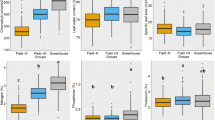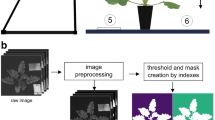Abstract
To establish new techniques for automatic classification of rhizosphere components, we investigated the utility of visible (VIS) and near–infrared (NIR) spectral images of the rhizosphere under two soil moisture conditions (mean volumetric water content: 0.39 and 0.16 cm3 cm−3). Spectral reflectance images of the belowground parts of hybrid poplar cuttings (Populus deltoides × P. euramericana, I45/51) grown in a rhizobox were recorded at 120 spectral bands ranging from 480 to 972 nm. We examined which wavelengths were suitable and the number of spectral bands needed to accurately classify live roots of four age classes, dead roots, leaf mold, and soil. VIS reflectance (<700 nm) of live roots first increased and then decreased with age, whereas NIR reflectance (≥700 nm) was stable in mature roots. The reflectance of dead roots was lower than that of mature roots in both the VIS and NIR spectral regions. VIS reflectance did not differ among dead roots, leaf mold, and soil, but the NIR reflectance was clearly lower in soil than in the other materials. The reflectance of leaf mold and soil increased mainly in the NIR spectral region with reducing soil moisture, but this increase did not affect the order of reflectance intensity among the rhizosphere components in general. Although the most suitable spectral bands statistically selected for classifying rhizosphere components differed somewhat between moist and dry conditions, the spectral bands 580–679 nm (VIS) and 848–894 nm (NIR) provided high reliability under both conditions. Classification accuracy was higher when using two to five VIS–NIR images (overall accuracy ≥87.8%) than three VIS images (red, green, and blue; accuracy <67.1%). The high accuracy with VIS–NIR was mainly due to successful separation of leaf mold and soil. Irrespective of soil moisture condition, the overall accuracy tended to be stable at 92–94% with use of four VIS–NIR images. The spectral bands effective in wet soil conditions could also be used for classification in dry conditions, with overall accuracies >86.9%. These results suggest that automatic image analysis using VIS–NIR images at four spectral bands, including red and NIR, allows for accurate classification of the growth stage or live/dead status of roots and distinguishes between leaf mold and soil.







Similar content being viewed by others
Abbreviations
- DAP:
-
Days after planting
- EVA:
-
Ethylene vinyl acetate
- NIR:
-
Near-infrared
- UV:
-
Ultraviolet
- VIS:
-
Visible
- VWC:
-
Volumetric water content
References
Aase JK, Tanaka DL (1991) Reflectance from four wheat residue cover densities as influenced by three soil backgrounds. Agron J 83:753–757
Aldakheel YY, Danson FM (1997) Spectral reflectance of dehydrating leaves: measurements and modelling. Int J Remote Sens 18:3683–3690
Allen WA, Gausman HW, Richardson AJ, Thomas JR (1969) Interaction of isotropic light with a compact plant leaf. J Opt Soc Am 59:1376–1379
Baldini E, Facini O, Nerozzi F, Rossi F, Rotondi A (1997) Leaf characteristics and optical properties of different woody species. Trees 12:73–81
Comas LH, Eissenstat DM, Lakso AN (2000) Assessing root death and root system dynamics in a study of grape canopy pruning. New Phytol 147:171–178
Conel JE, van den Bosch J, Grove CI (1993) Application of a two-stream radiative transfer model for leaf lignin and cellulose concentrations from spectral reflectance measurements. Part 2. In: Green RO (ed) Summaries of the Fourth Annual JPL Airborne Geoscience Workshop. National Aeronautics and Space Administration Jet Propulsion Laboratory, Pasadena, California, pp 45-51
Daughtry CST (2001) Discriminating crop residues from soil by shortwave infrared reflectance. Agron J 93:125–131
Daughtry CST, McMurtrey JE III, Chappele EW, Dulaney WP, Irons JR, Satterwhite MB (1995) Potential for discriminating crop residues from soil by reflectance and fluorescence. Agron J 87:165–171
Dawson TP, Curran PJ, Plummer SE (1998) LIBERTY: modeling the effects of leaf biochemical concentration on reflectance spectra. Remote Sens Environ 65:50–60
Gates DM, Keegan HJ, Schleter JC, Weidner VR (1965) Spectral properties of plants. Appl Opt 4:11–20
Gausman HW (1974) Leaf reflectance of near-infrared. Photogramm Eng 40:183–191
Gausman HW, Allen WA (1973) Optical parameters of leaves of 30 plant species. Plant Physiol 52:57–62
Gillon D, David J-F (2001) The use of near infrared reflectance spectroscopy to study chemical changes in the leaf litter consumed by saprophagous invertebrates. Soil Biol Biochem 33:2159–2161
Gillon D, Houssard C, Joffre R (1999) Using near-infrared reflectance spectroscopy to predict carbon, nitrogen and phosphorus content in heterogeneous plant material. Oecologia 118:173–182
Heeraman DA, Crown PH, Juma NG (1993) A color composite technique for detecting root dynamics of barley (Hordeum vulgare L.) from minirhizotron images. Plant Soil 157:275–287
Hendrick RL, Pregitzer KS (1992) The demography of fine roots in a northern hardwood forest. Ecology 73:1094–1104
Hishi T (2007) Heterogeneity of individual roots within the fine root architecture: causal links between physiological and ecosystem functions. J For Res 12:126–133
Hishi T, Takeda H (2005) Life cycles of individual roots in fine root system of Chamecyparis obtusa Sieb. et Zucc. J For Res 10:181–187
Irons JR, Weismiller RA, Peterson GW (1989) Soil reflectance. In: Asrar G (ed) Theory and applications of optical remote sensing. Wiley, New York, pp 66–106
Jacquemoud S, Baret F (1990) PROSPECT: a model of leaf optical properties spectra. Remote Sens Environ 34:75–91
Johnson MG, Tingey DT, Phillips DL, Storm MJ (2001) Advancing fine root research with minirhizotrons. Environ Exp Bot 45:263–289
Knapp AK, Carter GA (1998) Variability in leaf optical properties among 26 species from a broad range of habitats. Am J Bot 85:940–946
Larcher W (2001) Physiological plant ecology, 4th ed. Springer-Verlag, Berlin, p 513
Lobell DB, Asner GP (2002) Moisture effects on soil reflectance. Soil Sci Soc Am J 66:722–727
Majdi H, Öhrvik J (2004) Interactive effects of soil warming and fertilization on root production, mortality, and longevity in a Norway spruce stand in northern Sweden. Glob Chang Biol 10:182–188
Majdi H, Pregitzer K, Morén A-S, Nylund J-E, Göran IÅ (2005) Measuring fine root turnover in forest ecosystems. Plant Soil 276:1–8
Nagler PL, Daughtry CST, Goward SN (2000) Plant litter and soil reflectance. Remote Sens Environ 71:207–215
Nagler PL, Inoue Y, Glenn EP, Russ AL, Daughtry CST (2003) Cellulose absorption index (CAI) to quantify mixed soil–plant litter scenes. Remote Sens Environ 87:310–325
Norby RJ, Ledford J, Reilly CD, Miller NE, O’Neill EG (2004) Fine-root production dominates response of a deciduous forest to atmospheric CO2 enrichment. Proc Natl Acad Sci USA 101:9689–9693
Oguma H, Tsuchida S, Fujinuma Y (2002) The development of a hyper-spectral camera system for forest monitoring. J Remote Sens Soc Jpn 22:588–597 (in Japanese)
Pahlavanian AM, Silk WK (1988) Effect of temperature on spatial and temporal aspects of growth in the primary maize root. Plant Physiol 87:529–532
Richards JA, Jia X (1999) Remote sensing digital image analysis, 3rd ed. Springer-Verlag, Berlin, p 363
Roumet C, Picon-Cochard C, Dawson LA, Joffre R, Mayes R, Blanchard A, Brewer MJ (2006) Quantifying species composition in root mixtures using two methods: near-infrared reflectance spectroscopy and plant wax markers. New Phytol 170:631–638
Ruess RW, Hendrick RL, Burton AJ, Pregitzer KS, Sveinbjornsson B, Allen MF, Maurer GE (2003) Coupling fine root dynamics with ecosystem carbon cycling in black spruce forests of interior Alaska. Ecol Monogr 73:643–662
Schowengerdt RA (1983) Digital image classification. In: Schowengerdt RA (ed) Techniques for image processing and classification in remote sensing. Academic, New York, pp 129–214
Sharp RE, Silk WK, Hsiao TC (1988) Growth of the maize primary root at low water potentials. I. Spatial distribution of expansive growth. Plant Physiol 87:50–57
Slaton MR, Hunt ER Jr, Smith WK (2001) Estimating near-infrared leaf reflectance from leaf structural characteristics. Am J Bot 88:278–284
Smit AL, Zuin A (1996) Root growth dynamics of Brussels sprouts (Brassica oleracea var. gemmifera) and leeks (Allium porrum L.) as reflected by root length, root colour and UV fluorescence. Plant Soil 185:271–280
Smit AL, George E, Groenwold J (2000) Root observations and measurements at (transparent) interfaces with soil. In: Smit AL, Bengough AG, Engels C, van Noordwick M, Pellerin S, van de Geijn SC (eds) Root methods: a handbook. Springer-Verlag, Berlin, pp 235–271
Stoner ER, Baumgardner MF (1981) Characteristics in reflectance of surface soils. Soil Sci Soc Am J 45:1161–1165
Swain PH, Davis SM (1978) Remote sensing: the quantitative approach. McGraw-Hill, New York
Tardieu F, Simonneau T (1998) Variability among species of stomatal control under fluctuating soil water status and evaporative demand: modelling isohydric and anisohydric behaviours. J Exp Bot 49:419–432
Twomey SA, Bohren CF, Mergenthaleret JL (1986) Reflectance and albedo differences between wet and dry surfaces. Appl Opt 25:431–437
Wang Z, Burch WH, Mou P, Jones RH, Mitchell RJ (1995) Accuracy of visible and ultraviolet light for estimating live root proportions with minirhizotrons. Ecology 76:2330–2334
Watt M, Silk WK, Passioura JB (2006) Rates of root and organism growth, soil conditions, and temporal and spatial development of the rhizosphere. Ann Bot 97:839–855
Wells CE, Eissenstat DM (2001) Marked differences in survivorship among apple roots of different diameters. Ecology 82:882–892
Wiegand CL, Richardson AJ (1992) Relating spectral observations of the agricultural landscape to crop yield. Food Struct 11:249–258
Withington JM, Reich PB, Oleksyn J, Eissenstat DM (2006) Comparisons of structure and life span in roots and leaves among temperate trees. Ecol Monogr 76:381–397
Acknowledgements
We are greatly indebted to Dr. Y. Fujinuma, Dr. T. Takeda (National Institute for Environmental Studies), and Mr. R. Fukushi (Pasco Corporation) for technical support in the data analysis. This research was supported by Funding to Promote Creative Research in National Institute for Environmental Studies.
Author information
Authors and Affiliations
Corresponding author
Additional information
Responsible Editor: Philippe Hinsinger.
Rights and permissions
About this article
Cite this article
Nakaji, T., Noguchi, K. & Oguma, H. Classification of rhizosphere components using visible–near infrared spectral images. Plant Soil 310, 245–261 (2008). https://doi.org/10.1007/s11104-007-9478-z
Received:
Accepted:
Published:
Issue Date:
DOI: https://doi.org/10.1007/s11104-007-9478-z




